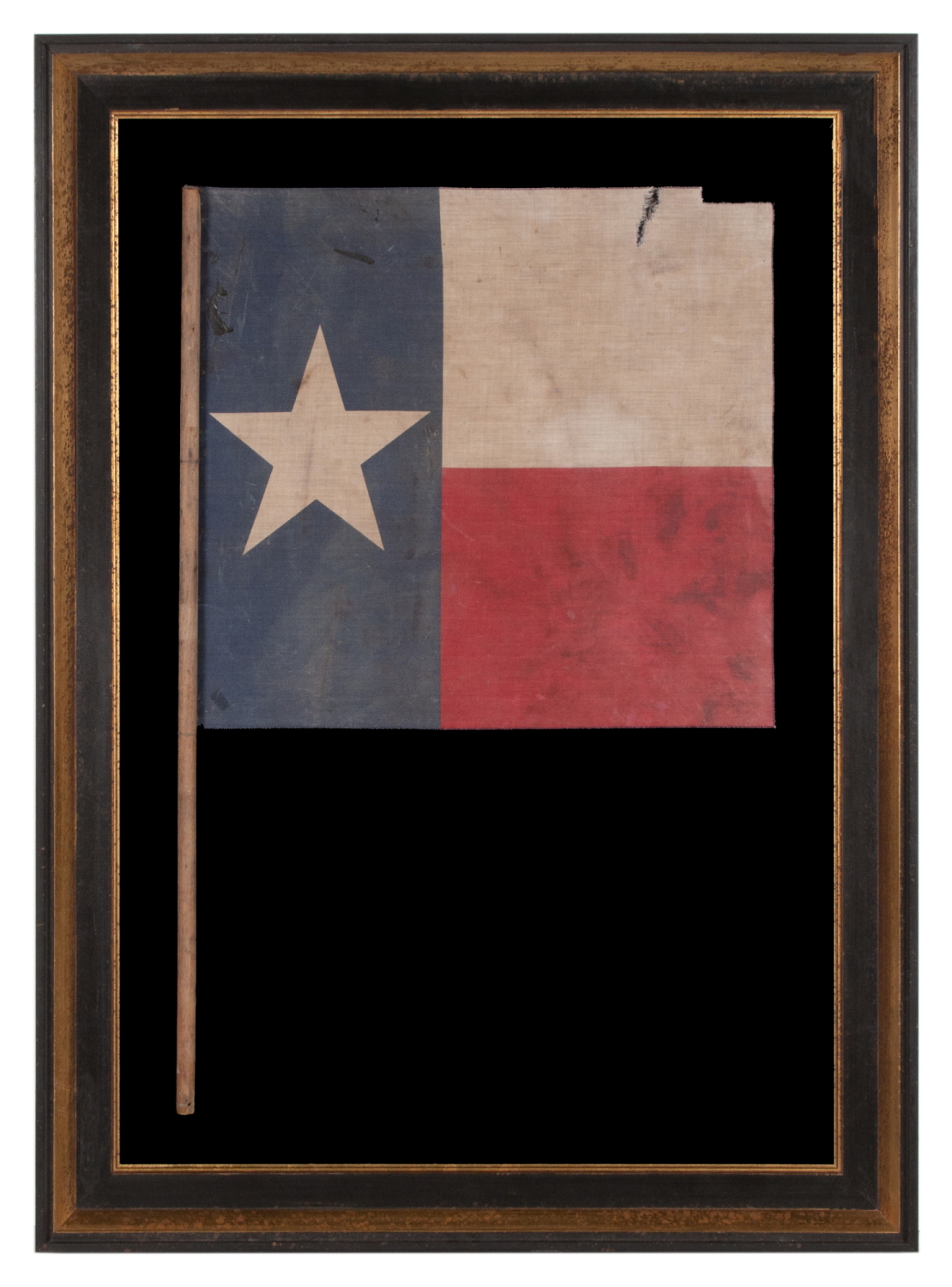
| |
FLAG OF THE REPUBLIC OF TEXAS, WHICH BECAME THE TEXAS STATE FLAG; AN UNUSUAL, SQUARE PROFILE PARADE FLAG ON ITS ORIGINAL AND RATHER SUBSTANTIAL STAFF, MADE CIRCA 1930 – 1950’s |
|
| Available: |
Sold |
| Frame Size (H x L): |
47" x 34.25" |
| Flag Size (H x L): |
23" x 31" on a 36" staff |
|
| Description....: |
|
Unusual format parade flag, in the form of the flag of the Republic of Texas, which eventually became the Texas State flag. Printed on plain weave cotton and bound along the edge by machine stitching in black thread, uncommon in printed flags, the flag is affixed to an unusually hefty wooden staff. The square profile mimics that of U.S. infantry and artillery battle flags, which needed this profile so as to be as large as possible, yet not drag on the ground when hand-carried. Though far smaller, at just 23 by 31 inches, versus 6 by 6.5 feet for 19th century American infantry flags, the design is an interesting one to see on any example. This was likely made for specific use, such as a theatrical presentation or a parade where there was some focus on the Texas revolution. Whatever the case may be, it has seen extended use, perhaps by children following the event, and displays wonderful patina as a result. Made sometime between roughly 1930 and the 1950’s, it is unique in my experience and presents beautifully. The staff seems to have been made specifically for it, shows legitimate wear and oxidation, and adds considerably to the presentation.
Brief History of the Flag of the Republic of Texas / Texas State Flag:
Although its designer remains unknown, a flag in this general design was introduced to the Congress of the Republic of Texas on December 28, 1838. Presented by Senator William H. Wharton, it was adopted on January 25, 1839 as the final of several national flag designs used to represent the Republic of Texas, when it was a nation unto itself. A man by the name of Dr. Charles B. Stewart is credited with the drawing, accepted by the Third Congress of the Republic, when it enacted the legislation through which the flag was officially adopted.
Use of one "Lone Star" in Texas symbolized its solidarity in declaring independence from Mexico. A single, large star appeared on what is known as the "Burnet Flag," which served as the national flag of the Republic of Texas from 1836 until 1839. It also appeared on the flags designed by Stephen F. Austin in 1835 and Lorenzo de Zavala in 1836, the latter of which was allegedly adopted in the Convention of 1836 at Washington-on-the-Brazos. It is of interest to note that flag historians also cite the use of a single, large star decades beforehand, in The Republic of West Florida, which existed in 1810 for a period of just over two and a half months.
It is also of interest to note that during the Civil War, the State Flag of Texas was sometimes married with that of the First Confederate National Flag (a.k.a., the Stars & Bars). The latter was very similar to the flag of Texas, instead displaying a blue canton in the upper, hoist-end corner, similar to the Stars & Stripes, on which there were a number of white stars to represent the count of Confederate States at any particular time. This grew as more states were accepted to the Confederacy. The canton was paired with a field of three horizontal bars, in red-white-red. Texas patriotism during the war sometimes led to the combination of the two flags, via the use of just one lone star on a flag in the First National design. Close variants of this can also be encountered.
Although design of the Flag of the Republic of Texas remained the de facto state flag from 1879 - 1933, there was technically no official state flag during this period. This is because, in 1879, all statutes not explicitly renewed by the state were repealed under something called the "Revised Civil Statutes of 1879." Since the statutes pertaining to the flag were not among those renewed in that year, Texas was formally flagless until the passage Texas Flag Code in 1933.
Mounting: The flag was mounted and framed within our own conservation department, which is led by expert trained staff. We take great care in the mounting and preservation of flags and have framed thousands of examples.
The background is 100% cotton twill, black in color, that has been washed and treated for colorfastness. The black-painted and hand-gilded and distressed molding is Italian. A deep shadowbox was created to accommodate the staff. The glazing is U.V. protective acrylic. Feel free to contact us for more details.
Condition: There is modest to moderate oxidation and staining in the star and in the white bar, accompanied by minor soiling along the binding. There is some fabric loss in the top, fly end corner and very minor losses with fraying along the fly end of the white bar. Many of my clients like vintage flags to show their age and history of use. |
|
|
|
| Collector Level: |
Intermediate-Level Collectors and Special Gifts |
|
| Flag Type: |
Parade flag |
|
| Star Count: |
Other |
|
| Earliest Date of Origin: |
1820 |
|
| Latest Date of Origin: |
1950 |
|
| State/Affiliation: |
Texas |
|
| War Association: |
|
|
| Price: |
SOLD |
|
| |
Views: 858 |
|
|
|

